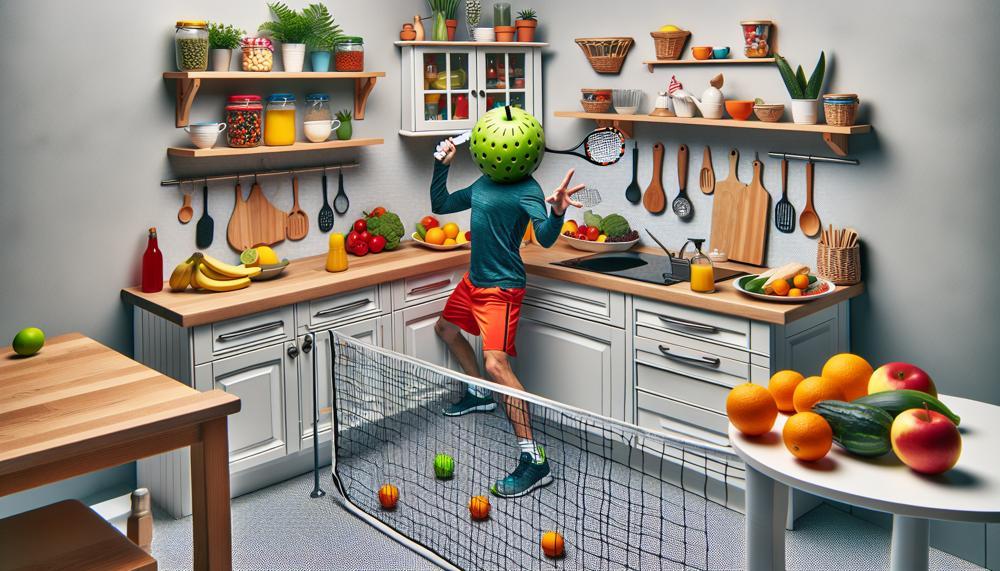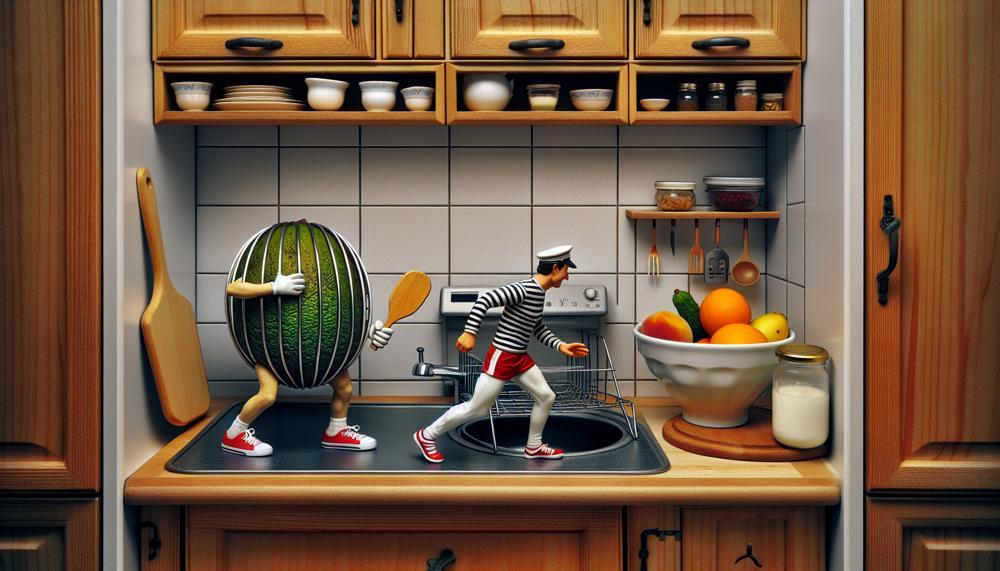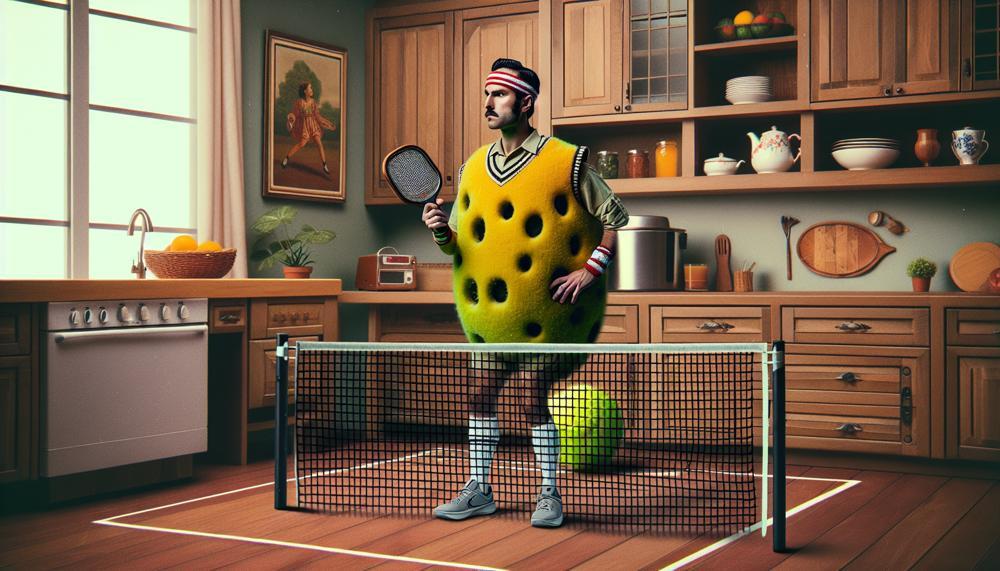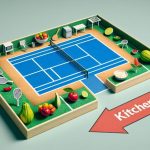Are you ready to dive into the nitty-gritty of this exhilarating sport? We all know that pickleball is a unique combination of tennis, badminton, and ping pong, but did you know that it also has its own set of rules and regulations?
And one crucial aspect of these rules is kitchen violations – when a player steps into the non-volley zone during gameplay. But who exactly has the authority to report these infractions?
Is it up to the players themselves or is there someone else in charge? In this blog post, we’ll be exploring the ins and outs of who holds the power to call out kitchen violations in pickleball.
So, grab your paddles and let’s get started on this informative journey.
Table of Contents
What is the pickleball kitchen rule?
Pickleball is a beloved sport that combines elements of tennis, badminton, and table tennis. It’s a game that has captured the hearts of players of all ages, thanks to its simple yet exciting gameplay. But as with any sport, pickleball has its own set of rules and regulations. And one of the most crucial among them is the kitchen rule.
So, what exactly is this kitchen rule in pickleball? It’s a rule that prevents players from standing at the net and smashing downward. In simpler terms, it prohibits players from being in contact with the kitchen zone or line while volleying a ball. This includes any object physically connected to them, like their partner, and even their momentum that may land them in the kitchen after a volley.
Now, you may wonder why such a rule is necessary. Well, the kitchen, also known as the non-volley zone, is a section of the court located 7 feet away from both sides of the net. Its purpose is to promote fair play by preventing players from taking advantage of their position at the net and making it easier for their opponents to return shots.
But there are certain details about this rule that may not be known to beginners. For instance, if an object falls into the kitchen during play, it is considered a fault. This applies to both the ball and any part of a player’s body or clothing. Moreover, players are strictly prohibited from initiating volleys while standing inside the kitchen. This means they must step back behind the non-volley line before hitting a shot.
The responsibility for enforcing the kitchen rule falls on both players themselves and officials in tournaments. While it is ultimately up to players to follow this rule, umpires are present to make calls when necessary.
It’s essential for players to practice “toeing the line” during dinking rallies, which means staying close to but not inside the kitchen line. This will help them stay aware of their position on the court and avoid kitchen faults.
For beginners, it’s crucial to focus on running up to the kitchen line as much as possible. This will not only improve their footwork and agility but also get them comfortable with staying behind the non-volley line during volleys.
Here are Five Important Pickleball Kitchen Facts
Here are Five Important Pickleball Kitchen Facts:
What is the purpose of the non-volley zone in pickleball?
The non-volley zone, also known as the kitchen zone, is a 7-foot area on both sides of the net in pickleball. Its purpose is to prevent players from engaging in volleys in close proximity, thus promoting a level playing field. This rule ensures that players do not gain an unfair advantage by standing too close to the net or utilizing any cunning maneuvers from this region.
What are some common faults that can occur while playing in the kitchen?
The kitchen rule may seem intricate at first, but grasping its essence is crucial for successful gameplay. Here are some frequent faults that may arise while competing in this area:
- Striking the ball before it bounces within the kitchen zone is considered a fault and awards a point to the opposing player.
- Accidentally dropping any item being worn or held while volleying in the kitchen also results in a fault.
- Leaping from the kitchen to execute a volley and landing outside of it constitutes a fault.
- These regulations apply even if a dead ball is declared before the violation.
Can you use your toes to gain an advantage in positioning during dink rallies?
Toeing the line (positioning feet just inches away from the kitchen line) can provide players with an edge in positioning during dink rallies. However, caution must be exercised not to step on or over the line while executing a volley, as it will result in a fault.
Can your partner touch you while volleying?
No, your partner cannot make contact with you while volleying. If they do, it will result in a fault.

What happens if your partner hits a ball outside of the kitchen while you are inside?
The play is deemed lawful as long as your partner does not commit a fault by striking a volley inside the kitchen.
This means that your partner can hit the ball outside of the kitchen, and you can still be inside without it being considered a fault.
Pickleball Kitchen: What Is It?

Over the years, pickleball has emerged as a popular sport, and for good reason. This exhilarating racket game combines the best aspects of tennis, badminton, and ping pong to create an electrifying experience for players of all ages.
However, for those new to the sport, the concept of the kitchen in pickleball may seem perplexing. What exactly is it and why is it so important? In this article, we will delve into the purpose of the kitchen zone and the crucial rules that revolve around it.
The Kitchen Zone
When it comes to pickleball, the kitchen refers to the non-volley zone, a 7-foot area on both sides of the net. This section is marked by a line extending from the net to 7 feet back on each side.
The main purpose of this zone is to prevent players from standing at the net and smashing everything downward, making the game monotonous.
This rule adds an extra layer of complexity to the game and encourages players to employ diverse strategies such as dinking and lobbing.
The Rules
The primary rule associated with the kitchen is that a player cannot be in contact with the kitchen zone or line while volleying a ball. This includes any objects physically connected to them or their momentum that leads them into the kitchen. A violation of this rule results in a fault and awards a point to the opposing team.
In addition to this significant rule, there are other crucial aspects of the kitchen that players should be mindful of. These include refraining from initiating a volley while inside the kitchen and not breaching the intent of the non-volley zone rule. For example, if a player hits a shot while outside of the kitchen but their momentum carries them into it, it is still considered a fault.
It is essential for players to be well-versed in these rules, especially in tournament play, where they may be called out for faults if they break them. It is the players’ responsibility to call out their own faults if they violate the kitchen rule or any other related rules. This underscores the importance of integrity and sportsmanship in the game of pickleball.
Tips to Avoid Kitchen Violations
To steer clear of kitchen violations, players should practice staying near, but not inside the kitchen line during dinking rallies. This allows them to maintain control of the game while also avoiding faults.
A look at the pickleball kitchen rules
Along with its growing popularity comes the responsibility for players to familiarize themselves with and adhere to the game’s specific set of regulations.
One crucial element that adds a layer of complexity to pickleball is the kitchen, also known as the non-volley zone.
This designated area on the court, marked by a solid line and extending 7 feet from the net on both sides, plays a vital role in the game. Understanding and abiding by the kitchen rules is essential for players to avoid penalties and emerge victorious in their matches.
So, what exactly are the restrictions for hitting a ball from this enigmatic kitchen area in pickleball? Let us delve deeper into this perplexing concept.
The Kitchen Rule
The kitchen rule in pickleball is clear and concise: a player cannot be physically connected to or touching the kitchen zone or kitchen line while volleying a ball. In simpler terms, a player cannot enter the kitchen to make a shot while the ball is in play.
If this rule is violated, it is considered a fault, resulting in a point for the opposing team and handing over the serve.
Physical Connection Counts
In pickleball, any object that is physically connected to a player is deemed as an extension of them. This includes their partner, paddle, or any other part of their body.
Therefore, even if just one toe grazes any part of the kitchen line or kitchen zone while making a shot, it is still considered a fault.
Momentum Matters
Momentum plays a significant role in understanding and executing the kitchen rule. If a player’s momentum causes them to step into the kitchen after making a volley, it is still considered a fault. The player must patiently wait for their momentum to bring them out of the kitchen before hitting another shot.
Bounce Rule
According to the bounce rule in pickleball, a player can only hit a ball from the kitchen area if it has bounced once. In other words, a player must allow the ball to bounce outside of the kitchen before they can make a shot if they are inside this restricted zone.
Exceptions to the Rule
As with any rule, there are exceptions to the kitchen rule in pickleball.
What you can do in the kitchen?
If you’re a fan of racket sports, chances are you’ve heard of pickleball – the exhilarating game that combines elements of tennis, badminton, and ping pong.
While it may seem like a simple game to pick up, there are crucial rules and techniques to keep in mind, especially when it comes to playing in the kitchen.
So, what exactly are you allowed to do in the kitchen during a game of pickleball? Let’s break it down.
Avoid Volleys
The first thing to keep in mind is that volleys (hitting the ball in the air without letting it bounce) are prohibited while standing in the non-volley zone, also known as the kitchen. This rule was implemented to prevent players from dominating the game by staying near the net and limiting their opponents’ chances of returning the ball.
Stay Outside the Kitchen
Another crucial rule is to always remain outside of the kitchen while making shots. It’s common for players to unintentionally step into the kitchen while hitting the ball, resulting in a fault and a point for the other team.
Pay Attention to the Kitchen Line
Strict adherence to the kitchen line is essential during gameplay. This means that players must not touch or cross over the line while making shots. Any contact with this line will result in a fault.
It’s vital to pay close attention to your positioning and momentum to avoid stepping on or crossing over the line.
Call Kitchen Violations
In pickleball, it’s up to the players themselves, as well as any referees or officials present, to call out kitchen violations.
This requires integrity and good sportsmanship from all players. If you notice a violation, don’t hesitate to speak up and address it.
Utilize Advanced Techniques
The kitchen can also be utilized strategically in pickleball by utilizing advanced techniques such as dinking and the Ernie shot.
These techniques can give you an advantage in gameplay and keep your opponents on their toes.
Clarify Common Misconceptions
There are a few misconceptions about the kitchen that should be clarified to avoid unnecessary faults. For example, jumping over the kitchen is allowed as long as there is no contact with the kitchen line or any part of the kitchen area.
Toe the line
“Toeing the line” was a phrase my father often used when I was growing up, constantly reminding me to follow rules and conform to societal norms. However, as I delved into psychology research later in life, I came to realize that sometimes it takes straying from the conventional path to make real progress.
Pickleball is a game that demands quick reflexes, strategic thinking, and precise shots. Its popularity has grown in recent years, but with that comes a greater responsibility to understand the rules and regulations of the game. One of the most discussed rules in pickleball is the kitchen violation, which occurs when a player steps into the non-volley zone and hits a volley shot. But who holds the authority to call out a kitchen violation in pickleball? Let’s delve into this question and explore the role of “toeing the line” in preventing such violations.
“Toeing the line” in pickleball means staying behind the non-volley zone line while hitting or returning the ball. This rule aims to prevent players from gaining an unfair advantage by being too close to the net. When serving or returning a serve, players must keep both feet behind the non-volley zone line until after hitting the ball. This ensures that players do not step into the kitchen and hit a volley shot, which is considered an illegal move.
Who has call out a kitchen violation in pickleball?
According to official USAPA (USA Pickleball Association) rules, any player on either team can make this call. This means that not only can your opponent call you out for stepping into the kitchen, but your own partner can also do so if they notice a violation.
This rule aims to ensure fair play and avoid any disputes or arguments regarding kitchen violations. It is crucial for players to remember that anyone on the court can make this call, and it is their responsibility to be aware of their own and their opponent’s movements.
As mentioned earlier, “toeing the line” is crucial in preventing kitchen violations. By staying behind the non-volley zone line, players are following the rules and avoiding any potential faults or penalties.
This not only ensures fair play but also prevents any disputes or arguments between players.
It is imperative for players to familiarize themselves with the rules and adhere to them to avoid any unnecessary violations.
Conclusion
In conclusion, the kitchen rule in pickleball is a fundamental element of the game that upholds fairness and good sportsmanship. While it may seem confusing at first, players can improve their gameplay by understanding and adhering to this rule. Both players and officials have a responsibility to enforce it, highlighting its significance in maintaining an equal playing field.
By familiarizing ourselves with the non-volley zone, also known as the kitchen, we gain a deeper understanding of its role in promoting fair and consistent gameplay. Whether you’re a novice or a seasoned player, it’s crucial to remember that anyone on the court can call out a kitchen violation. This emphasizes the importance of being mindful of our movements and staying within the boundaries during dinking rallies.
So next time you step onto the pickleball court, keep your toes behind the non-volley zone line and strive for fair play. As my father always said, sometimes it takes “toeing the line” to make real progress – both on and off the court. Let’s aim for excellence in our gameplay while upholding sportsmanship values.






